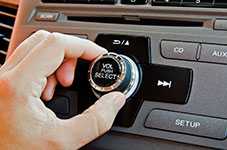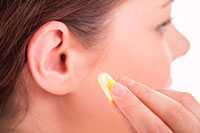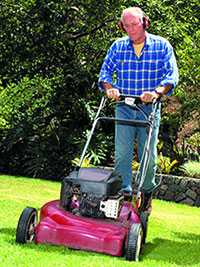How Do I Prevent Hearing Loss from Loud Noise?
The effect of noise on hearing depends on how loud it is (sound intensity) and how long it lasts (duration). Avoiding noisy situations is the best prevention. If you can’t avoid the noise, use adequate hearing protection.
If You Need to Shout…the Sound is Too Loud
Even without a device to measure sound, you can typically tell if the noise around you is too loud. If you or others need to shout in order to be heard or cannot understand each other even at arm’s length away, the sound is too loud and may damage your hearing over time.

Turn down the volume.
5 Ways to Protect Your Hearing
- Turn the volume down.
- Walk away from the loud noise.
- Take breaks from the noise.
- Avoid loud, noisy activities and places.
- Use hearing protection.
Recommendations to Help Prevent Hearing Loss from Loud Noise
At Home
- Turn down the volume of the TV, radio, or music.
- If listening to loud music, take listening breaks to reduce your exposure.
- Use quieter products (power tools, toys, recreational vehicles) whenever they are available. (For more, visit CDC’s Buy Quiet webpage.)
- Reduce equipment noise by replacing worn, loose, or unbalanced machine parts. Keep equipment well lubricated and maintained.
- Use hearing protection devices (such as earplugs and earmuffs) when you cannot avoid loud sounds.
- Make hearing protection convenient. Stash earplugs in your car or workshop for easy access.
- Keep children away from loud music or equipment at home.
At Public Events
- Move or stay far away from the loudest sound-producing source—such as loudspeakers or cannons at college stadiums—especially if attending with children.
- Limit the length of time of exposure to loud sounds.
- Pay attention to signs and information flyers warning of possible loud noise and the use of hearing protection.
- Bring hearing protection devices with you. Keep them in your car, pockets, or other easy to access place.
What about During Pregnancy and for Infants and Children?
For more information about pregnancy and noise at work, visit CDC’s Reproductive Health and the Workplace webpage.
For more information about hearing loss in children, visit
During pregnancy, use the same precautions specified above for at home and public events. Also try to avoid your body touching the source of the noise (i.e., vibration).
For children and infants, also use the same precautions specified above. And keep children away from high noise levels, such as from very loud toys.
Use Hearing Protection
The best way to protect your hearing from noise is to avoid noisy activities. When you can’t avoid loud noise, use hearing protection. Hearing protection devices reduce the level of sound entering your ear. They do not block out sound completely. Hearing protection that does not fit properly will not protect your hearing.
Look for Noise Reduction Ratings
More about Noise Reduction
The actual sound reduction may be lower than the number listed for the device even when worn correctly. As a basic guide, you can
- reduce the manufacturer’s noise reduction rating by 25% for earmuffs,
- reduce the manufacturer’s noise reduction rating by half (50%) for foam earplugs, and
- reduce the manufacturer’s noise reduction rating by 70% for all other earplugs.
For more information, see NIOSH’s technical review manual.
Hearing protection devices come with different noise reduction ratings. The noise reduction rating is usually labeled on the device container (it may say “NRR”) and it indicates the amount of potential protection the device provides.
Noise reduction ratings are measured in decibels (dB). Most hearing protection devices have ratings that range from 0 dB to 35 dB. A noise reduction rating is a “best case” rating measured in a laboratory; the actual sound reduction provided by the protector may be much less. It is best to choose a hearing protector that is comfortable and convenient, and that you are willing to wear consistently when exposed to noise. If you want to know exactly how much noise reduction you are getting, you can have the device “fit-tested” by a hearing professional.
Choose the Right Hearing Protection
The choice of hearing protection device depends on your personal preferences of comfort and where you will wear it. How well the protection works depends on whether you wear it consistently and correctly. The most common types of hearing protection devices include earplugs, earmuffs, and specially made devices.

Insert-Type Earplugs
These devices provide an air-tight seal in the ear canal. They are generally cheap, effective, and easy to use. They can be any of the following types:
- Pre-molded (pliable devices of fixed proportions)
- Formable (usually made of expandable foam)
- Custom-molded (to fit precisely the size and shape of an individual’s ear canal)
- Canal caps (earplugs on a flexible plastic or metal band) (During quiet times, when not needed, you can leave the canal caps hanging around your neck so they will be easy to find when needed.)
For more information about insert-type earplugs, visit CDC’s “How to Wear Soft Foam Earplugs” web page.

Earmuffs
Earmuffs come in many models designed to fit most people. They block out noise by completely covering the outer ear. Some earmuffs also include electronic parts to help users communicate or to block sound impulses or background noise. However, earmuffs might not work as well for people with heavy beards, sideburns, or glasses (which can create gaps between the earmuff cushion and your skull).
Note: Wearing both earmuffs and earplugs can reduce the sound further. However, the noise reduction ratings for the two do not add together.
Specially Made Devices
You can also get specially made hearing protection devices. They can be styled and sized specifically for a person’s individual ear. They can also have special features:
- Custom earplugs molded to fit your ear exactly.
- Earmuffs with built-in radios or communication devices that allow you to listen at a safe level while still protecting you from the loud noise outside (such as at sporting events).
- “Level-dependent” hearing protectors (such as earmuffs) that do not block sound when the environment is quiet, but block loud sounds. These can be very useful for hunters.
- Lightweight active noise cancellation headphones for reducing low-frequency noise (for example, in airplane cabins). Noise cancelling devices work best for low-pitched droning sounds, such as from car and airplane engines and air conditioners. (These devices do not have a noise reduction rating.)
- Uniform-attenuation earplugs for musicians and concert attendees. These devices act just like turning down the volume on a stereo (in other words, the sound intensity is decreased).
For More Information
- For a list of available hearing protection devices by type and feature, visit NIOSH’s Hearing Protector Device Compendium.
- For more information on fit testing, visit NIOSH’s Science Blog—HPD Well-Fit™: The Future is Fit-Testing.
- To learn more about how to properly wear hearing protection devices, visit NIOSH’s website—Choose the Hearing Protection That’s Right for You.
- For more about noise in the workplace, visit NIOSH’s website—Noise and Hearing Loss.
Sound Level Meters Can Help Measure Noise
You can use a sound level meter to measure noise around you. You don’t have to be a health professional to own one, either.
You can find free sound level meters developed as apps for smartphones. These smartphone apps typically display noise levels in decibels, and they can even show you the risk for hearing loss. Smartphone apps must be calibrated to ensure that the readings are accurate.
For more information on the accuracy of these apps, visit NIOSH’s Science Blog — So How Accurate Are These Smartphone Sound Measurement Apps?
- Page last reviewed: February 6, 2017
- Page last updated: February 6, 2017
- Content source:


 ShareCompartir
ShareCompartir